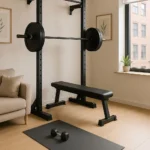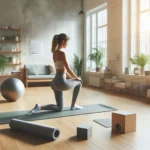Introduction: Transform Your Fitness Journey with Somatic Pilates
Are you feeling stuck in your home workout routine? Despite your best efforts, do you still struggle with nagging muscle tension, poor posture, or inconsistent fitness results? If so, it might be time to explore the transformative practice of Somatic Pilates.
Unlike traditional workouts that focus primarily on repetition and external form, Somatic Pilates combines the precision of classical Pilates with neuromuscular re-education to create a truly revolutionary approach to movement. This mind-body practice helps you release chronic tension patterns while building functional strength and flexibility from the inside out.
What makes Somatic Pilates particularly appealing for home fitness enthusiasts is its minimal equipment requirements and focus on quality of movement rather than quantity. By integrating these techniques into your existing routine, you can enhance your overall fitness experience without investing in expensive equipment or studio memberships.
In this comprehensive guide, we’ll explore ten compelling reasons why Somatic Pilates deserves a place in your home gym plan, and how this transformative practice can elevate your fitness journey to new heights.
What Exactly Is Somatic Pilates?
Understanding the Somatic Pilates Approach
Somatic Pilates represents an innovative fusion of traditional Pilates principles with somatic education techniques. While conventional Pilates focuses on core strength, alignment, and controlled movements, Somatic Pilates adds a crucial neurological dimension, emphasizing internal awareness and sensory feedback.
At its foundation, Somatic Pilates is built on the understanding that many movement limitations and pain patterns stem from how our nervous system controls our muscles. Thomas Hanna, the founder of Somatics, observed that chronic stress and habitual movement patterns can lead to what he called “sensory-motor amnesia” – the loss of conscious control over certain muscle groups.
By combining Joseph Pilates’ emphasis on core stability and controlled movement with Hanna’s focus on neuromuscular repatterning, Somatic Pilates offers a comprehensive approach that addresses both the physical and neurological aspects of movement.
Core Principles That Make Somatic Pilates Unique
What truly sets Somatic Pilates apart from other exercise modalities are these fundamental principles:
- Sensory awareness and proprioception: Rather than simply moving through exercises, practitioners are guided to sense and feel each movement from within.
- Neuromuscular repatterning: Exercises are designed to re-educate the nervous system and restore voluntary control over chronically tight muscles.
- Mind-body integration: Every movement involves conscious attention and mental engagement, creating stronger neural pathways for improved movement patterns.
- Quality over quantity: The focus is on the precision and awareness of each movement rather than repetitions or intensity.
- Self-regulation: Practitioners learn to balance their autonomic nervous system, shifting between effort and recovery for sustainable progress.
By incorporating these principles into your home fitness routine, you’ll experience a fundamentally different approach to exercise – one that works with your body’s natural intelligence rather than forcing it into prescribed patterns.
10 Powerful Benefits of Adding Somatic Pilates to Your Home Routine
1. Releases Chronic Muscle Tension and Pain
One of the most immediate benefits of Somatic Pilates is its remarkable ability to release chronic muscle tension. Unlike conventional stretching that often works against the body’s protective mechanisms, Somatic Pilates utilizes pandiculation – a natural neuromuscular process of contracting and slowly releasing muscles while maintaining sensory awareness.
This approach works directly with your nervous system to reset muscle length and tone. For example, many people struggle with chronically tight hip flexors from prolonged sitting. Traditional stretching often provides only temporary relief, but Somatic Pilates techniques can help restore voluntary control over these muscles, creating lasting change in tissue quality and movement freedom.
By incorporating somatic movements like the “arch and flatten” or “hip hikes” into your home routine, you can address common tension patterns in the back, neck, and shoulders that might be limiting your overall fitness progress.
2. Improves Posture Without Constant Reminders
Do you find yourself constantly needing to remember to “sit up straight” or “pull your shoulders back”? Somatic Pilates offers a different approach to postural improvement by retraining your nervous system’s baseline awareness of your body’s position in space.
Rather than forcing an externally imposed “correct” position, Somatic Pilates helps you rediscover your natural, effortless alignment. Through guided explorations of subtle movements and positional awareness, your nervous system learns to maintain balanced muscle tone throughout your postural muscles.
Simple daily practices like the “seated length and reach” or “standing weight shifts” can dramatically improve your proprioceptive awareness, leading to naturally improved posture throughout your day – without the constant mental reminders.
3. Enhances Mind-Body Connection for Greater Movement Efficiency
In today’s distracted world, many of us move through life on autopilot, paying little attention to how we’re using our bodies. Somatic Pilates reverses this trend by cultivating a refined mind-body connection that enhances movement efficiency in everything you do.
By practicing slow, mindful movements with full sensory attention, you build neural pathways that support more coordinated, graceful, and efficient movement patterns. This enhanced neurological connection means you’ll get more out of every exercise in your fitness routine, as your body learns to engage the right muscles at the right time with the right amount of effort.
This improved movement efficiency translates directly to daily activities as well, whether you’re lifting groceries, playing with children, or participating in recreational sports.
4. Accelerates Recovery Between Workouts
Recovery is perhaps the most underappreciated component of an effective fitness program. Somatic Pilates excels at activating the parasympathetic “rest and digest” branch of your nervous system, which is essential for optimal recovery between more intense training sessions.
Through slow, mindful movements and conscious breathing patterns, Somatic Pilates helps downregulate stress hormones and promotes increased circulation to tissues that might be holding tension from previous workouts. This accelerated recovery process means you can bounce back more quickly between training sessions and reduce your risk of overtraining.
A simple 15-minute Somatic Pilates routine after a strength training session or intense cardiovascular workout can significantly improve recovery outcomes and help you maintain consistent progress in your fitness journey.
5. Creates Balanced Strength Without Bulk
For those seeking functional strength that supports daily activities and overall wellness, Somatic Pilates offers an ideal approach. Rather than isolating individual muscles for aesthetic development, Somatic Pilates builds integrated, whole-body strength through coordinated movement patterns.
This approach targets not just the visible “prime mover” muscles but also the deep stabilizers that provide joint support and movement control. By activating these often-neglected muscle groups through conscious awareness, you develop a more balanced strength profile that supports improved movement quality in all activities.
The result is a strong, capable body that functions optimally in real-world movements – without necessarily creating significant muscle hypertrophy or bulk.
6. Increases Flexibility Through Neurological Pathways
Traditional approaches to flexibility often focus exclusively on stretching the physical tissue, but Somatic Pilates recognizes that range of motion limitations frequently stem from neurological restrictions rather than tissue length.
When your nervous system perceives a movement as potentially dangerous, it will limit your range of motion as a protective mechanism. Through gentle, controlled explorations of movement possibilities, Somatic Pilates helps your nervous system recognize that these movements are safe, gradually expanding your comfortable range of motion.
This neurologically-based approach to flexibility creates more lasting changes than passive stretching alone. Movements like the “side-lying rotation” or “gentle spinal articulations” can create remarkable improvements in functional flexibility that transfer directly to your other workouts and daily activities.
7. Requires Minimal Equipment for Maximum Results
In an era of ever-more-complex fitness equipment, Somatic Pilates stands out for its beautiful simplicity. To practice effectively at home, you need very little specialized equipment – typically just a comfortable mat and perhaps a small pillow or cushion for head support.
While some practitioners enjoy using small props like foam rollers, stability balls, or resistance bands to enhance certain exercises, these are entirely optional. The primary focus in Somatic Pilates is on developing sensory awareness and movement control, which requires no equipment at all.
This minimalist approach makes Somatic Pilates an ideal complement to home fitness programs, as it requires very little space or financial investment while delivering significant results in movement quality and physical wellbeing.
8. Offers Adaptability for All Fitness Levels
One of the most remarkable aspects of Somatic Pilates is its inherent adaptability. Because the practice focuses on internal sensation and movement quality rather than achieving predetermined positions, it naturally scales to meet each individual’s current capabilities.
A single Somatic Pilates movement exploration can be profoundly beneficial for both a deconditioned beginner and an elite athlete – each will experience the movement differently and find appropriate challenges within their current ability level.
This self-scaling nature makes Somatic Pilates particularly well-suited for home practice, as you can trust your body’s feedback to guide the intensity and complexity of your movement explorations. Whether you’re just beginning your fitness journey or looking to refine advanced movement skills, Somatic Pilates offers an appropriate entry point and progression path.
9. Prevents Injuries Through Enhanced Body Awareness
Many fitness-related injuries occur when we push beyond our body’s current capabilities or move with poor mechanical alignment. Somatic Pilates dramatically reduces these injury risks by developing heightened proprioception – your sense of where your body is in space and how it’s moving.
This enhanced body awareness helps you recognize your actual limitations rather than pushing through pain signals. You’ll develop the ability to detect subtle compensations or alignment issues before they develop into injuries, allowing you to make small adjustments that keep you moving safely.
For example, the somatic “cross-lateral connection” exercises help you sense the relationship between opposite limbs, improving coordination and reducing the risk of movement compensations that could lead to injury.
10. Creates Sustainable Fitness Habits Through Enjoyment
Perhaps the most important benefit of Somatic Pilates for long-term fitness success is the inherent enjoyment it brings to movement practice. Unlike workout approaches that rely on external motivation or focus primarily on distant goals, Somatic Pilates cultivates an appreciation for the movement itself.
The mindful, exploratory nature of the practice creates a sense of curiosity and discovery that many practitioners find deeply satisfying. This intrinsic enjoyment of the process – rather than just the outcomes – helps establish sustainable movement habits that can last a lifetime.
When you genuinely look forward to your movement practice because of how it makes you feel during the experience (not just afterward), you’re much more likely to maintain consistency in your fitness routine over the long term.
How to Integrate Somatic Pilates Into Your Home Gym Routine
Getting Started with Somatic Pilates at Home
Beginning a Somatic Pilates practice at home is remarkably simple. Start with just 10-15 minutes daily of basic somatic movements, focusing on slow, mindful execution and internal sensation rather than external form.
Here’s a simple starter sequence to try:
- Arch and flatten: Lying on your back, slowly alternate between gently arching and flattening your lower back while noticing the changing sensations in your core and spine.
- Head rolls: Lying on your back, slowly roll your head from side to side, noticing areas of ease and restriction.
- Shoulder rolls: Gently circle your shoulders while sensing the movement of your shoulder blades against the floor.
- Hip clocks: Imagine your pelvis as the face of a clock and slowly circle it in both directions, noticing which “hours” feel most restricted.
For learning resources, consider books like “Somatics” by Thomas Hanna or “Your Body, Your Yoga” by Bernie Clark. Online platforms like Movement for Modern Life, Pilates Anytime, and Embodia offer excellent Somatic Pilates instructional videos for home practitioners.
Creating a Progressive Somatic Pilates Practice Plan
As you become more familiar with the basic principles, you can create a progressive practice plan that systematically develops your somatic awareness and movement capabilities. Here’s a simple 4-week structure to follow:
Week 1: Foundation
- Focus on basic somatic movements like arch and flatten, side-bending, and gentle rotations
- Practice for 10-15 minutes daily, emphasizing sensory awareness
- Notice and record your observations about areas of tension or restriction
Week 2: Integration
- Begin connecting individual movements into flowing sequences
- Increase practice time to 15-20 minutes daily
- Begin noticing how somatic awareness carries into your daily activities
Week 3: Application
- Apply somatic principles to basic Pilates movements like the hundred, roll-ups, or leg circles
- Practice for 20-25 minutes, alternating between pure somatic explorations and integrated Pilates exercises
- Notice improvements in your execution of traditional movements
Week 4: Personalization
- Develop a personalized routine that addresses your specific needs and goals
- Practice for 25-30 minutes, creating a balanced practice of exploration and structured exercise
- Begin integrating somatic awareness into your other workout modalities
Track your progress not just through physical changes but through improvements in sensory awareness, movement quality, and your subjective experience of ease and comfort in various positions.
Combining Somatic Pilates with Other Exercise Modalities
Somatic Pilates works beautifully as a complement to other exercise approaches. Consider these integration strategies:
With Strength Training:
- Use a 10-minute Somatic Pilates warm-up to prepare your nervous system for movement
- Incorporate somatic awareness cues during strength exercises to improve form and muscular recruitment
- End with 10 minutes of somatic movements to release tension patterns and improve recovery
With Cardiovascular Exercise:
- Practice brief somatic check-ins before cardio to establish baseline awareness
- After cardio, use somatic movements to help your system transition from sympathetic to parasympathetic activation
- Notice how improved somatic awareness affects your running, cycling, or swimming technique
Sample Weekly Schedule:
- Monday: 30 min strength training + 15 min Somatic Pilates
- Tuesday: 30 min cardiovascular exercise + 10 min Somatic Pilates
- Wednesday: 45 min full Somatic Pilates session
- Thursday: 30 min strength training + 15 min Somatic Pilates
- Friday: 30 min cardiovascular exercise + 10 min Somatic Pilates
- Saturday: 30 min mixed modality + 15 min Somatic Pilates
- Sunday: 30 min gentle Somatic Pilates exploration
This balanced approach allows you to maintain variety in your fitness routine while gradually building somatic awareness throughout all movement practices.
Common Questions About Home-Based Somatic Pilates
Is Somatic Pilates Effective Without an Instructor?
While working with a qualified Somatic Pilates instructor can certainly accelerate your learning, home practice can be very effective when approached mindfully. The key is to focus on internal sensation rather than external appearance, moving slowly enough to notice subtle changes in your body’s responses.
To maximize learning in a self-directed environment:
- Record yourself occasionally to check basic alignment
- Use mirrors strategically but don’t become dependent on visual feedback
- Focus on how movements feel rather than how they look
- Start with well-explained foundational movements before attempting more complex patterns
Many practitioners find that alternating between occasional in-person instruction and consistent home practice provides an ideal learning environment, allowing for both expert guidance and personal exploration.
How Does Somatic Pilates Compare to Traditional Pilates?
While traditional Pilates and Somatic Pilates share many principles, there are key differences in approach and emphasis:
Traditional Pilates:
- Focuses more on specific exercise sequences and forms
- Emphasizes core strength and spinal alignment
- Often uses specialized equipment like reformers or Cadillacs
- Typically involves more vigorous, flowing routines
Somatic Pilates:
- Places greater emphasis on sensory awareness and nervous system regulation
- Moves more slowly, especially when learning new patterns
- Focuses on releasing chronic tension patterns before building strength
- Often uses fewer repetitions but with more attentional focus
Many practitioners find value in both approaches, using Somatic Pilates to address movement limitations and develop awareness, while incorporating traditional Pilates for more structured strength development and challenge.
How Quickly Will I See Results with Somatic Pilates?
The timeline for experiencing benefits from Somatic Pilates varies depending on your starting point and specific goals, but many practitioners report noticeable changes within the first 2-3 weeks of consistent practice.
Initial changes often include:
- Improved sense of ease in daily movements
- Reduced muscle tension, particularly in the neck, shoulders, and lower back
- Better sleep quality and stress regulation
- Increased awareness of habitual movement patterns
More significant physical changes like improved posture, increased strength, and enhanced flexibility typically become apparent after 4-8 weeks of regular practice. Remember that the neurological adaptations that create lasting change occur gradually through consistent practice rather than through occasional intense sessions.
Can Somatic Pilates Help with Specific Conditions?
Somatic Pilates has shown particular promise for several common conditions, though it should complement rather than replace appropriate medical care:
For Back Pain: Somatic Pilates excels at addressing the muscular tension patterns often associated with back pain, particularly by releasing chronically contracted muscles and improving movement coordination. The gentle, non-aggravating nature of the practice makes it suitable even during acute pain episodes.
For Stress and Anxiety: The emphasis on slow, mindful movement and conscious breathing helps activate the parasympathetic nervous system, reducing stress hormone levels and creating a state of calm alertness. Many practitioners report improved stress resilience with regular practice.
For Athletic Performance: Athletes often discover that Somatic Pilates helps them identify and release unconscious tension patterns that limit performance. The enhanced body awareness translates to more efficient technique and better movement coordination in their sport.
If you have specific medical conditions, it’s always advisable to consult with healthcare providers before beginning any new movement practice, and to modify exercises as needed based on your individual circumstances.
Advanced Somatic Pilates Strategies for Home Practitioners
Developing Sensory Acuity for Self-Correction
As your practice deepens, developing refined sensory awareness becomes increasingly important for continued progress. Advanced practitioners focus on subtle internal cues that guide movement quality:
- Muscular effort: Notice the difference between 20%, 50%, and 80% effort in different movements
- Breath-movement coordination: Explore how different breathing patterns affect the quality of each movement
- Ground force awareness: Sense how your body interacts with the floor or other supporting surfaces
- Internal space perception: Develop awareness of the three-dimensional space within your body
Try this practice: During familiar movements, close your eyes and focus exclusively on internal sensation rather than external form. Notice what new information becomes available when you shift attention inward.
Creating Your Own Somatic Pilates Flow Sequences
As you gain experience, you can begin designing personalized movement sequences that address your specific needs and goals. Effective self-designed practices typically follow this structure:
- Centering (3-5 minutes): Begin with breath awareness and gentle movements to establish baseline sensory awareness
- Release work (5-10 minutes): Address areas of chronic tension through slow, mindful explorations
- Integration (10-15 minutes): Connect isolated movements into flowing sequences that coordinate multiple body regions
- Challenge (5-10 minutes): Introduce more complex movement patterns that build on your established awareness
- Integration (3-5 minutes): Return to simple, whole-body movements that consolidate your learning
When creating your sequences, prioritize movements that challenge your current limitations while remaining within a range where you can maintain full sensory awareness and control.
Conclusion: Transforming Your Fitness Journey Through Somatic Awareness
Adding Somatic Pilates to your home gym routine offers far more than just another set of exercises – it provides a fundamentally different approach to movement that can transform your entire fitness experience. By addressing both the physical and neurological aspects of movement, Somatic Pilates helps create lasting change in how you feel and function in your body.
The beauty of this practice lies in its accessibility and sustainability. With minimal equipment requirements and adaptability to all fitness levels, Somatic Pilates can become a cornerstone of your movement practice that continues to provide benefits for years to come.
Perhaps most importantly, the emphasis on internal awareness rather than external achievement creates a more enjoyable, sustainable approach to fitness – one based on curiosity, exploration, and genuine appreciation for your body’s remarkable capabilities.
As you begin integrating Somatic Pilates into your home fitness routine, remember that consistency matters more than intensity. Even 10-15 minutes of mindful somatic exploration daily can create significant shifts in your movement quality, body awareness, and overall wellbeing.
If you’re ready to dive deeper into Somatic Pilates and truly understand the principles behind this transformative practice, I highly recommend checking out Pilates for Beginners: Core Pilates Exercises and Easy Sequences to Practice at Home This book offers practical guidance, insightful explanations, and step-by-step exercises that are perfect for anyone practicing at home. It’s been a game-changer in my own routine, and it’s a valuable resource for building a sustainable, mindful movement practice.







